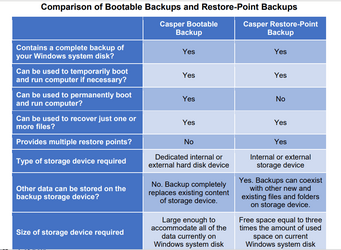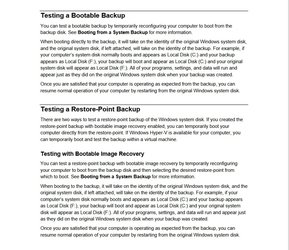Has anyone used Casper 11 or Casper Secure 6 for cloning or imaging? Is the software reliable?
Some people here have used it but it is not cheap. Frankly, it is not a mainstream app like Macrium Reflect, AOMEI Backupper or Easeus Todo all of which offer a good basic free version which is adequate for most users, with premium featurers at a cost.
I did test it a while back but was not majorly impressed. However, it is the only tool I know that has a feature similar to Macrium Reflect Home's (paid version) Rapid Delta Restore but I have never tested it.
It is interesting to note from latest Macrium Reflect update:
- We've fixed a bug that caused a program crash if a disk was connected that was originally cloned using a 3rd party product called 'Casper'.
Obviously Casper was doing something non standard that Reflect found a workaround to fix.
In the end, the most popular apps are popular for a reason, with reliability being paramount - especially Macrium Reflect

.
Price wise the paid version is pretty much same as Macrium Reflect.
It seems to have a similar feature to Macrium Viboot (
available on free version of Reflect) whereby an image can be loaded as a Hyper-V VM. I am not certain, but its image backups (from Windows 10 onwards) seem to be a clone to a VHDX file rather than a compressed image file, so I think the image backups must be larger than Reflect backups but I accept I may be wrong on this. Nowhere in the guide below is compression mentioned. It seems to be quite storage hungry - 3 x amount of used space for images on Reflect would hold around 5 images (I rarely hold 3 or more - just keeping last two).

Macrium Viboot also works on Home versions of Windows 10/11 using Virtualbox.
From guide :
"The VHDX image file format is supported only when running on Windows 8 and later or when booting and running from a Casper Startup Disk created with the Windows 8 or later ADK. Bootable image recovery is supported only on Windows 7 and later. Testing a restore-point backup within a virtual machine is supported only when running on Windows 10 and later."
https://download.fssdev.com/download/userguide/en-US/fss_casper_110_userguide.pdf
I could not see any reference to differential or incremental backups but that may be just different terminology. If it cannot do this, this would be a major downside, compared with mainstream image tools.
Price for price, I cannot see any major driver to go for Casper (compared with paid version of Reflect), but of course, even the free version of Reflect is quite powerful and meets most users needs.
I admit to being totally biased towards Macrium Reflect as it has never let me down (2/3rds of members of this forum use it according to latest poll). In the end, does Casper have such a proven reliability track record?
Only one way to find out though if prepared to splash the cash.......










